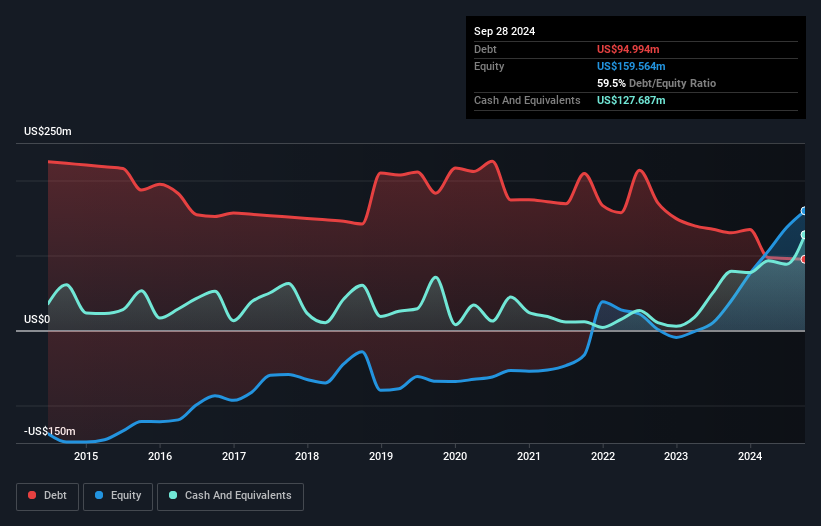
Legendary fund manager Li Lu (who Charlie Munger backed) once said, 'The biggest investment risk is not the volatility of prices, but whether you will suffer a permanent loss of capital.' When we think about how risky a company is, we always like to look at its use of debt, since debt overload can lead to ruin. As with many other companies Blue Bird Corporation (NASDAQ:BLBD) makes use of debt. But the more important question is: how much risk is that debt creating?
When Is Debt A Problem?
Debt and other liabilities become risky for a business when it cannot easily fulfill those obligations, either with free cash flow or by raising capital at an attractive price. Ultimately, if the company can't fulfill its legal obligations to repay debt, shareholders could walk away with nothing. While that is not too common, we often do see indebted companies permanently diluting shareholders because lenders force them to raise capital at a distressed price. Having said that, the most common situation is where a company manages its debt reasonably well - and to its own advantage. When we examine debt levels, we first consider both cash and debt levels, together.
View our latest analysis for Blue Bird
What Is Blue Bird's Net Debt?
You can click the graphic below for the historical numbers, but it shows that Blue Bird had US$95.0m of debt in September 2024, down from US$130.3m, one year before. But on the other hand it also has US$127.7m in cash, leading to a US$32.7m net cash position.

How Healthy Is Blue Bird's Balance Sheet?
The latest balance sheet data shows that Blue Bird had liabilities of US$236.0m due within a year, and liabilities of US$129.4m falling due after that. Offsetting these obligations, it had cash of US$127.7m as well as receivables valued at US$59.1m due within 12 months. So its liabilities total US$178.5m more than the combination of its cash and short-term receivables.
Since publicly traded Blue Bird shares are worth a total of US$1.36b, it seems unlikely that this level of liabilities would be a major threat. Having said that, it's clear that we should continue to monitor its balance sheet, lest it change for the worse. Despite its noteworthy liabilities, Blue Bird boasts net cash, so it's fair to say it does not have a heavy debt load!
Better yet, Blue Bird grew its EBIT by 179% last year, which is an impressive improvement. If maintained that growth will make the debt even more manageable in the years ahead. There's no doubt that we learn most about debt from the balance sheet. But it is future earnings, more than anything, that will determine Blue Bird's ability to maintain a healthy balance sheet going forward. So if you're focused on the future you can check out this free report showing analyst profit forecasts.
Finally, a company can only pay off debt with cold hard cash, not accounting profits. Blue Bird may have net cash on the balance sheet, but it is still interesting to look at how well the business converts its earnings before interest and tax (EBIT) to free cash flow, because that will influence both its need for, and its capacity to manage debt. Happily for any shareholders, Blue Bird actually produced more free cash flow than EBIT over the last two years. That sort of strong cash conversion gets us as excited as the crowd when the beat drops at a Daft Punk concert.
Summing Up
Although Blue Bird's balance sheet isn't particularly strong, due to the total liabilities, it is clearly positive to see that it has net cash of US$32.7m. And it impressed us with free cash flow of US$96m, being 110% of its EBIT. So we don't think Blue Bird's use of debt is risky. Another factor that would give us confidence in Blue Bird would be if insiders have been buying shares: if you're conscious of that signal too, you can find out instantly by clicking this link.
When all is said and done, sometimes its easier to focus on companies that don't even need debt. Readers can access a list of growth stocks with zero net debt 100% free, right now.
Valuation is complex, but we're here to simplify it.
Discover if Blue Bird might be undervalued or overvalued with our detailed analysis, featuring fair value estimates, potential risks, dividends, insider trades, and its financial condition.
Access Free AnalysisHave feedback on this article? Concerned about the content? Get in touch with us directly. Alternatively, email editorial-team (at) simplywallst.com.
This article by Simply Wall St is general in nature. We provide commentary based on historical data and analyst forecasts only using an unbiased methodology and our articles are not intended to be financial advice. It does not constitute a recommendation to buy or sell any stock, and does not take account of your objectives, or your financial situation. We aim to bring you long-term focused analysis driven by fundamental data. Note that our analysis may not factor in the latest price-sensitive company announcements or qualitative material. Simply Wall St has no position in any stocks mentioned.
About NasdaqGM:BLBD
Blue Bird
Designs, engineers, manufactures, and sells school buses in the United States, Canada, and internationally.
Flawless balance sheet and undervalued.
Similar Companies
Market Insights
Community Narratives


